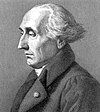Lagrange, Euler, and Kovalevskaya tops
In classical mechanics, the rotation of a rigid body such as a spinning top under the influence of gravity is not, in general, an integrable problem. There are however three famous cases that are integrable, the Euler, the Lagrange, and the Kovalevskaya top, which are in fact the only integrable cases when the system is subject to holonomic constraints.[1][2][3] In addition to the energy, each of these tops involves two additional constants of motion that give rise to the integrability.
The Euler top describes a free top without any particular symmetry moving in the absence of any external torque, and for which the fixed point is the center of gravity. The Lagrange top is a symmetric top, in which two moments of inertia are the same and the center of gravity lies on the symmetry axis. The Kovalevskaya top[4][5] is a special symmetric top with a unique ratio of the moments of inertia which satisfy the relation
That is, two moments of inertia are equal, the third is half as large, and the center of gravity is located in the plane perpendicular to the symmetry axis (parallel to the plane of the two degenerate principle axes).
Hamiltonian formulation of classical tops
[edit]The configuration of a classical top[6] is described at time by three time-dependent principal axes, defined by the three orthogonal vectors , and with corresponding moments of inertia , and and the angular velocity about those axes. In a Hamiltonian formulation of classical tops, the conjugate dynamical variables are the components of the angular momentum vector along the principal axes
and the z-components of the three principal axes,
The Poisson bracket relations of these variables is given by
If the position of the center of mass is given by , then the Hamiltonian of a top is given by
The equations of motion are then determined by
Explicitly, these are and cyclic permutations of the indices.
Mathematical description of phase space
[edit]In mathematical terms, the spatial configuration of the body is described by a point on the Lie group , the three-dimensional rotation group, which is the rotation matrix from the lab frame to the body frame. The full configuration space or phase space is the cotangent bundle , with the fibers parametrizing the angular momentum at spatial configuration . The Hamiltonian is a function on this phase space.
Euler top
[edit]The Euler top, named after Leonhard Euler, is an untorqued top (for example, a top in free fall), with Hamiltonian
The four constants of motion are the energy and the three components of angular momentum in the lab frame,
Lagrange top
[edit]The Lagrange top,[7] named after Joseph-Louis Lagrange, is a symmetric top with the center of mass along the symmetry axis at location, , with Hamiltonian
The four constants of motion are the energy , the angular momentum component along the symmetry axis, , the angular momentum in the z-direction
and the magnitude of the n-vector
Kovalevskaya top
[edit]The Kovalevskaya top[4][5] is a symmetric top in which , and the center of mass lies in the plane perpendicular to the symmetry axis . It was discovered by Sofia Kovalevskaya in 1888 and presented in her paper "Sur le problème de la rotation d'un corps solide autour d'un point fixe", which won the Prix Bordin from the French Academy of Sciences in 1888. The Hamiltonian is
The four constants of motion are the energy , the Kovalevskaya invariant
where the variables are defined by
the angular momentum component in the z-direction,
and the magnitude of the n-vector
Nonholonomic constraints
[edit]If the constraints are relaxed to allow nonholonomic constraints, there are other possible integrable tops besides the three well-known cases. The nonholonomic Goryachev–Chaplygin top (introduced by D. Goryachev in 1900[8] and integrated by Sergey Chaplygin in 1948[9][10]) is also integrable (). Its center of gravity lies in the equatorial plane.[11]
See also
[edit]References
[edit]- ^ Audin, Michèle (1996), Spinning Tops: A Course on Integrable Systems, New York: Cambridge University Press, ISBN 9780521779197.
- ^ Whittaker, E. T. (1952). A Treatise on the Analytical Dynamics of Particles and Rigid Bodies. Cambridge University Press. ISBN 9780521358835.
- ^ Strogatz, Steven (2019). Infinite Powers. New York: Houghton Mifflin Harcourt. p. 287. ISBN 978-1786492968.
More importantly she [Sofja Wassiljewna Kowalewskaja] proved that no other solvable tops could exist. She had found the last one
- ^ a b Kovalevskaya, Sofia (1889), "Sur le problème de la rotation d'un corps solide autour d'un point fixe", Acta Mathematica (in French), 12: 177–232
- ^ a b Perelemov, A. M. (2002). Teoret. Mat. Fiz., Volume 131, Number 2, pp. 197–205. (in French)
- ^ Herbert Goldstein, Charles P. Poole, and John L. Safko (2002). Classical Mechanics (3rd Edition), Addison-Wesley. ISBN 9780201657029.
- ^ Cushman, R.H.; Bates, L.M. (1997), "The Lagrange top", Global Aspects of Classical Integrable Systems, Basel: Birkhäuser, pp. 187–270, doi:10.1007/978-3-0348-8891-2_5, ISBN 978-3-0348-9817-1.
- ^ Goryachev, D. (1900). "On the motion of a rigid material body about a fixed point in the case A = B = C", Mat. Sb., 21. (in Russian). Cited in Bechlivanidis & van Moerbek (1987) and Hazewinkel (2012).
- ^ Chaplygin, S.A. (1948). "A new case of rotation of a rigid body, supported at one point", Collected Works, Vol. I, pp. 118–124. Moscow: Gostekhizdat. (in Russian). Cited in Bechlivanidis & van Moerbek (1987) and Hazewinkel (2012).
- ^ Bechlivanidis, C.; van Moerbek, P. (1987), "The Goryachev–Chaplygin Top and the Toda Lattice", Communications in Mathematical Physics, 110 (2): 317–324, Bibcode:1987CMaPh.110..317B, doi:10.1007/BF01207371, S2CID 119927045
- ^ Hazewinkel, Michiel; ed. (2012). Encyclopaedia of Mathematics, pp. 271–2. Springer. ISBN 9789401512886.











































